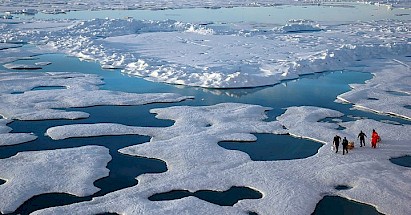We still have a chance to stop the Arctic summer sea ice from melting
 There’s still time to save the Arctic summer sea ice at risk of disappearing by mid-century if countries around the world immediately do everything possible to reduce methane emissions, a new study says.
There’s still time to save the Arctic summer sea ice at risk of disappearing by mid-century if countries around the world immediately do everything possible to reduce methane emissions, a new study says.
“Even though the risk of having ice-free Arctic summers is very imminent, it is not unavoidable,” said Tianyi Sun, lead author of the study, published March 15 by the Environmental Defense Fund. “But the key is we have to start right now.”
A 2019 study found that if the Arctic Ocean is free of sea ice during the sunlit part of the year, it could generate the same heat as 25 years worth of human-caused carbon dioxide (CO2) emissions at today’s level.
But if the world achieves net-zero CO2 emissions by 2050 and quickly enacts all practical measures to reduce methane emissions starting immediately, the chances of preserving the Arctic summer sea ice this century could increase from nearly zero to more than 80 per cent, the study found.
Along with exacerbating global warming, losing Arctic summer sea ice will erode coastlines, devastate Arctic ecosystems, destroy the infrastructure and ways of life of northern communities and cause global sea-level rise unless something changes — and fast.
“There has been a lot of emphasis on reducing CO2 emissions because every little bit we make will matter for such a long time, and there has been less attention on methane and its oversized impact on near-term temperature,” said Sun.
The extent of global warming is mainly tied to CO2 because it remains in the air for centuries, while methane lingers for just over a decade but captures over 80 times more heat than an equal amount of CO2.
The world already has the tools to reduce methane emissions by 55 per cent from the current policy baseline within the decade, said Sun.
The largest source of methane emissions is agriculture, but fossil fuels are a close second and present the most cost-effective solutions to reduce methane emissions.
The oil and gas industry alone could reduce three-quarters of its methane emissions with existing technologies, almost 45 per cent of which could be implemented at no net cost, according to a November report by the International Energy Agency (IEA). Because methane is the main component of natural gas, companies could capture and sell methane otherwise vented into the atmosphere and completely offset the costs of reducing those emissions, the IEA estimated.
Many of these measures are very easy, like simply detecting methane leaks at abandoned oil and gas wells and putting policy in place to stop methane from being vented or burned instead of captured. Sun says continued technological advancements, such as methane-detecting satellites, will make it easier to locate and plug leaks.
At the United Nations climate conference in November, world leaders from more than 100 countries committed to reducing global methane emissions 30 per cent below 2020 levels by 2030.
This Global Methane Pledge is a “great big step in the right direction” because the quicker we act, the more beneficial methane emission reductions will be, said Sun.
The study looked at different scenarios for cutting back on methane and CO2 pollution from 2020 to 2090 and found slow action on methane is better than delayed action.
Currently, the world is not on track to achieve net-zero emissions by 2050, according to the United Nations. However, if the world acts quickly to slash methane emissions, we can still preserve the Arctic summer sea ice even if we miss that target, according to the study.
“There’s always a significant benefit from acting on methane, no matter what you do on CO2,” said Sun. “But at some point within the century, we have to (reach net-zero emissions) because every little bit of CO2 emitted into the atmosphere will last there virtually forever, compared to human timescales.”
Sun said the study used relatively simple climate models and would love to see other researchers look at this problem using “more complex Earth system models.”
“We’re considering Arctic summer sea ice as this one single system. We’re thinking about it being there or not being there,” she said. “But in the real world, the Arctic summer sea ice system is more complicated than that.”
Although it is possible to regrow Arctic summer sea ice if the planet cools down, Sun says there could still be irreversible impacts on Arctic ecosystems and communities because we simply don’t know the full extent of having sustained ice-free summers.
The study noted without mitigation measures, methane emissions are predicted to double from current levels by the end of the century. A previous study by the Environmental Defense Fund found slashing methane emissions quickly could slow the planet’s speed of warming by an estimated 30 per cent.
Over the past two decades, the Arctic has lost about one-third of its winter sea ice volume, according to a new study published in the journal Geophysical Research Letters. By mid-century, all the thickest ice that can endure the summer heat will be replaced with thinner seasonal ice, which will melt completely in the summer months.
These studies show there are methane-cutting tools and technologies available today that can have a big impact on the fate of Arctic summer sea ice and the rate of global warming, but only if the world acts with urgency to implement them.
You can return to the main Market News page, or press the Back button on your browser.

